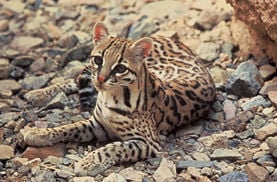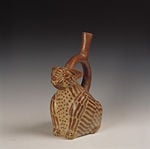Ocelot
| Ocelot[1] | ||||||||||||||
|---|---|---|---|---|---|---|---|---|---|---|---|---|---|---|
 Ocelot
| ||||||||||||||
| Scientific classification | ||||||||||||||
| ||||||||||||||
| Leopardus pardalis (Linnaeus, 1758) | ||||||||||||||
 Ocelot range
|
Ocelot (Leopardus pardalis, formerly Felis pardalis) is a nocturnal, New World wild cat (family Felidae), up to about three or four feet (.9 to 1.2 meters) in length, including the tail, and characterized by a grayish to orange yellow fur with black markings and ringed tail. Also known as the painted leopard, McKenney's wildcat, or manigordo, the ocelot is distributed over South and Central America and Mexico, but has been reported as far north as Texas and in Trinidad, in the Caribbean.
Leopardus pardalis exhibits a bi-level functionality, playing a valuable ecological role, while also advancing its own survival, reproduction, and maintenance. Ocelots are an integral component of ecosystems, limiting the population size of rodents, rabbits, monkeys, and other prey. Additionally, they have been a source of wonder for people, both today, such as in zoos, and historically, such as for the Moche people of ancient Peru, who worshiped animals and often depicted ocelots in their art (Berrin and Larco 1997).
Ocelots also have been valued for their fur. However, exploitation for the fur trade, including trapping of up to 200,000 a year from the early 1960s to mid-1970, severely reduced populations in some parts of their range (Grzimek et al. 2004) The feline was classified a "vulnerable" endangered species from the 1980s until 1996, but is now generally considered "least concern" by the 2006 IUCN Red List.
Overview and description
The ocelot is part of the Felidae family, which belongs to the Carnivora order within the mammals (Class Mammalia). Members of the family are called cats and sometimes felines. Cats are more strictly carnivorous (meat eating) than most other members of Carnivora (carnivores). The teeth of cats are well suited to their diet, with long canines for gripping prey and blade-like molars for cutting flesh (Voelker 1986).
All cats walk on four feet, in a digitigrade manner‚ÄĒthat is on their toes. Their hind legs are longer and stronger than their fore legs, which gives them strength for sprinting and leaping, but not stamina for long distance running. Cats have claws on their feet that are used for gripping prey, for fighting, and for climbing. In the ocelot, as with most cats, the claws can be retracted into the toes, which helps keep them sharp. The bodies of all cats (except some breeds of domestic cat) are covered with thick fur. In most species, this is spotted or striped.
Felidae usually is divided into two subfamilies, Pantherinae (which includes "big cats" like lions, jaguars, tigers, and leopards) and Felinae (which includes the "small cats," although some can be large, like the cougar). The ocelot, placed in species Leopardus pardalis, is part of the Felinae subfamily. The ocelot was formerly listed as Felis pardalis and was first described by Linnaeus in 1758.
Leopardus pardalis ranges from about 65 to 97 centimeters (26 to 38 inches) in length, not including a 27 to 40 centimeter (11 to 16 inch) tail (Grzimek et al. 2004). Ocelots range in weight roughly between 8.5 and 16 kilograms (18 to 35 pounds) (Grzimek et al. 2004). Males tend to be slightly larger than the females, with the average male weight ranging from 10 to 11.5 kilograms (22 to 25.3 pounds) and the female body weight from 8.8 to 9.4 kilograms (19.4 to 20.7 pounds) (Langenburg and Mulheisen 2003). The ocelot is the largest of the generally dainty Leopardus wild cat genus. While similar in appearance to the oncilla and the margay, which inhabit the same region, the ocelot is larger.
Forest dwelling ocelots tend to have a more yellow or orange-yellow coat, while those living in arid scrub tend to be grayer (Grzimek et al. 2004). There are black markings (spots, rosettes, rings, and stripes) on the head, neck, body, and tail, with black bands (ringed bars) on the tail, oval spots arranged in bands on the body, spots on the head, and stripes (black lines) on both cheeks. On the back of each ear, ocelots have a single white spot, and some white markings around the eyes and mouth (Langenburg and Mulheisen 2003). The underbelly is white or lighter. The ocelot's appearance is similar to that of the domestic cat. Its fur resembles that of a clouded leopard or jaguar.
The name ocelot comes from the Nahuatl word ŇćcńďlŇćtl (pronounced [oňźňąseňźloňźt…¨]), which usually refers to jaguars (Panthera onca) rather than ocelots (Pickett 2000; Karttunen 1983; Lockhart 2001).
Distribution and habitat
The ocelot has a geographic range from northern Argentina to southwestern Texas (Langenburg and Mulheisen 2003; Grzimek et al. 2004).
The ocelot once inhabited the chaparral thickets of the Gulf coast in south and eastern Texas, and was found in Arizona. In the United States, it now ranges only in several small areas of dense thicket in south Texas. The ocelot's continued presence in the United States is questionable, due largely to the introduction of dogs, the loss of habitat, and the introduction of highways. Young male Ocelots while searching for territory are frequently killed by cars.
The feline was classified a "vulnerable" endangered species from the 1980s until 1996, but is now generally considered "least concern" by the IUCN Red List. The Texas ocelot subspecies, Leopardus pardalis albescens, is still classified as endangered as of the IUCN's 2006 red list.
Ocelots live in a variety of different habitats, including tropical forest, marshes, savanna (grassland ecosystem with scattered trees or shrubs), mangroves, dense thorn shrub, and mountainous regions (Langenburg and Mulheisen 2003; Grzimek et al. 2004). They do require dense cover.
Behavior and reproduction
The ocelot is mostly nocturnal and very territorial. It will fight fiercely, sometimes to the death, in territorial disputes. Like most felines, it is solitary, usually meeting only to mate. However, during the day it rests in trees or other dense foliage, and will occasionally share its spot with another ocelot of the same sex. Home ranges vary from about 2 to 31 square kilometers (0.8 to 12 square miles) (Grzimek et al. 2004).
When mating, the female will find a den in a cave in a rocky bluff, a hollow tree, or a dense (preferably thorny) thicket. The gestation period is estimated to be from 79 to 85 days (Langenburg and Mulheisen 2003; Grzimek et al. 2004). Generally, the female will have a small litter size of one or two young, rarely three ((Langenburg and Mulheisen 2003)). Males mature at approximately 15 months, while the minimal breeding age for females is 18 months (Langenburg and Mulheisen 2003). In the tropics, breeding takes place year round, with females entering estrus an average of every four to six months (Langenburg and Mulheisen 2003). Females provide all of the parental care, with the young independent at one year (Langenburg and Mulheisen 2003; Grzimek et al. 2004).
The ocelot is well equipped for an arboreal lifestyle, being an excellent climber, and it will sometimes take to the trees; however, it is mostly terrestrial. It is an excellent swimmer (Grzimek et al. 2004).
Prey includes almost any small animal: monkeys, snakes, rodents, rabbits, lesser anteaters, turtles, iguanas, fish, amphibians, and birds are common prey, as are freshwater crustaceans and small domestic animals such as baby pigs and poultry. Almost all of the prey that the ocelot hunts is far smaller than itself. Studies suggest that it follows and finds terrestrial prey via odor trails, but the ocelot also has very keen vision, including night vision.
Subspecies
The following are the currently recognized subspecies:[1]
- Leopardus pardalis pardalis, Amazon Rainforest
- Leopardus pardalis aequatorialis, northern Andes and Central America
- Leopardus pardalis albescens, Mexico, southwestern Texas
- Leopardus pardalis melanurus, Venezuela, Guyana, Trinidad, Barbados, Grenada
- Leopardus pardalis mitis, Argentina, Paraguay
- Leopardus pardalis nelsoni, Mexico
- Leopardus pardalis pseudopardalis, Colombia
- Leopardus pardalis puseaus, Ecuador
- Leopardus pardalis sonoriensis, Mexico
- Leopardus pardalis steinbachi, Bolivia
Notes
- ‚ÜĎ 1.0 1.1 W. C. Wozencraft, "Order Carnivora," page(s) 539 in D. E. Wilson and D. M. Reeder, eds., Mammal Species of the World: A Taxonomic and Geographic Reference. (Baltimore: Johns Hopkins University Press, 2005). ISBN 0801882214.
ReferencesISBN links support NWE through referral fees
- Berrin, K., and Larco Museum. 1997. The Spirit of Ancient Peru: Treasures from the Museo Arqueológico Rafael Larco Herrera. New York: Thames and Hudson. ISBN 0500018022.
- Grzimek, B., D. G. Kleiman, V. Geist, and M. C. McDade. 2004. Grzimek's Animal Life Encyclopedia. Detroit: Thomson-Gale. ISBN 0787657883.
- Karttunen, F. E. 1983. An Analytical Dictionary of Nahuatl. Austin, TX: University of Texas Press. ISBN 0292703651.
- Langenburg, L., and M. Mulheisen. 2003. Leopardus pardalis. Animal Diversity Web. Retrieved May 18, 2008.
- Lockhart, J. 2001. Nahuatl as Written: Lessons in Older Written Nahuatl, with Copious Examples and Texts. Stanford, CA: Stanford University Press. ISBN 0804742820.
- Pickett, J. P., et al. (eds.) 2000. Ocelot. The American Heritage Dictionary of the English Language, 4th ed. Boston: Houghton Mifflin. Retrieved May 18, 2008.
- Voelker, W. 1986. The Natural History of Living Mammals. Medford, New Jersey: Plexus Publishing. ISBN 0937548081.
- Wozencraft, W. 2005. Order Carnivora. Pp. 532-628 in D. E. Wilson and D. M. Reeder, eds. Mammal Species of the World: A Taxonomic and Geographic Reference. Baltimore: Johns Hopkins University Press. ISBN 0801882214.
Credits
New World Encyclopedia writers and editors rewrote and completed the Wikipedia article in accordance with New World Encyclopedia standards. This article abides by terms of the Creative Commons CC-by-sa 3.0 License (CC-by-sa), which may be used and disseminated with proper attribution. Credit is due under the terms of this license that can reference both the New World Encyclopedia contributors and the selfless volunteer contributors of the Wikimedia Foundation. To cite this article click here for a list of acceptable citing formats.The history of earlier contributions by wikipedians is accessible to researchers here:
The history of this article since it was imported to New World Encyclopedia:
Note: Some restrictions may apply to use of individual images which are separately licensed.


